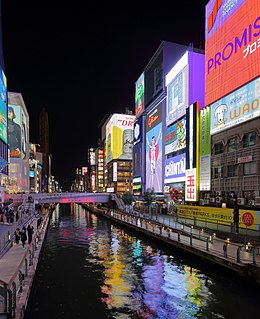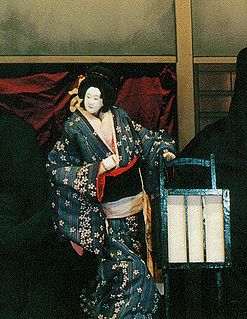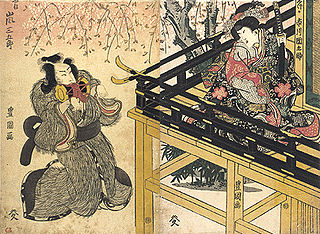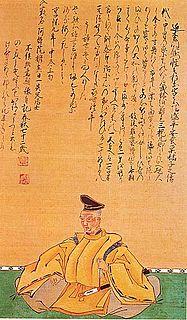
Chikamatsu Monzaemon was a Japanese dramatist of jōruri, the form of puppet theater that later came to be known as bunraku, and the live-actor drama, kabuki. The Encyclopædia Britannica has written that he is "widely regarded as the greatest Japanese dramatist". His most famous plays deal with double-suicides of honor bound lovers.

Namiki Sōsuke, also known as Namiki Senryū, was a prominent Japanese playwright who wrote for both kabuki and bunraku. He produced around 47 bunraku plays, nearly 40 of them composed for jōruri, a particular form of musical narrative, and 10 kabuki plays. He is considered the second greatest Japanese playwright after Chikamatsu Monzaemon.

Bandō Shūka I, also known as Bandō Tamasaburō I, was a Japanese Kabuki actor, and the first in the lineage to hold each of the stage-names Shūka and Tamasaburō.

Bandō Mitsugorō III was a Kabuki actor, one of the best tachiyaku of the early 19th century. He is famous for a great many roles, and for his rivalry with the Kamigata (Kyoto-Osaka) actor Nakamura Utaemon III.

Ichikawa Danjūrō VII was a Japanese kabuki actor who specialized in male hero (tachiyaku) roles, said to be the greatest of the 19th century. He was responsible for the establishment of the Kabuki Jūhachiban, a collection of the eighteen greatest plays in the repertoire.
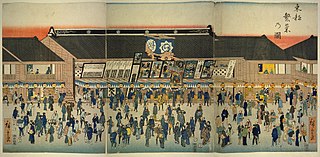
The Kawarazaki-za (河原崎座) was one of the major kabuki theatres in Edo during the Edo period and into the Meiji period. Not being one of the four theatres formally licensed by the Tokugawa shogunate, the theatre was largely inactive for long stretches of time, operating only when the Morita-za, facing financial difficulties or physical destruction of its theatre building, temporarily loaned its license to the Kawarazaki-za. It was established in 1656 and was managed by members of the Kawarazaki family of actors until 1875.

The Konpira Grand Theatre, also known as the Kanamaru-za (金丸座) is a restored Kabuki theatre in Kotohira, Kagawa, on the island of Shikoku, Japan. It was originally constructed in 1835, and is the oldest kabuki theatre in Japan. Kabuki plays are performed for one month each year, usually in April.
Sakata Tōjūrō IV is a Japanese kabuki actor in the Kamigata style. and is officially designated a Living National Treasure. Unlike most kabuki actors, he performs both male and female roles, and is renowned as both a skilled wagotoshi and onnagata. He is the fourth in the line of Sakata Tōjūrō, having revived the name after a lapse of over 230 years.

The Shinbashi Enbujō is a theatre in the Ginza neighborhood of Tokyo, Japan. It is a major kabuki venue, though other types of performances take place there as well.
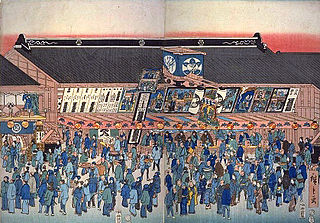
The Ichimura-za (市村座) was a major kabuki theatre in the Japanese capital of Edo, for much of the Edo period, and into the 20th century. It was first opened in 1634 and was run by members of the Ichimura family for much of the following nearly three centuries before it was destroyed by fire in 1932. It has not been rebuilt.

Kataoka Nizaemon XII was a Japanese kabuki actor of the Kamigata tradition; also known as Jinzaemon. His violent death at the hands of a starving writer living on the actor's property has been cited by scholars such as John Dower as an example of the chaos and "social disintegration" in the months and years immediately following Japan's defeat in World War II.
Shōsuke Nakawa is a Japanese playwright and theater director. Under the name Yoshizō Nakagawa, he serves as an advisor to the Shōchiku Corporation which produces kabuki, and is heavily involved in reviving Kamigata kabuki traditions. He is also head of the Kamigata Kabuki-juku (school) and actively works with actor Ichikawa Ennosuke III on reviving old kabuki plays Nakawa has been described as a walking dictionary of Kamigata kabuki information.

Bust portrait of Actor Kataoka Ichizō I is an ukiyo-e woodblock print belonging to the permanent collection of the Prince Takamado Gallery of Japan at the Royal Ontario Museum, Canada. The print dates to around the mid nineteenth century, and is an example of kamigata-e, that is prints produced in the Osaka and Kyoto areas. The ROM attributes the print to Gochōtei Sadamasu II, more usually referred to as Utagawa Sadamasu II. Other institutions, however, identify Utagawa Kunimasu—also known as Sadamasu I—as its author.

Kataoka Ichizō is a kabuki stage name which originated in the Osaka theatre, but whose actors are now based in Tokyo. The name has been passed down from the early 19th-century to the present day through six generations. The jōmon (定紋) family crest used to represent the line is the ichō no maru (銀杏丸) inverted ginko leaf design.

Actor Nakamura Shikan II as Satake Shinjūrō is an ukiyo-e woodblock print by Osaka-based late Edo period print designer Shungyōsai Hokusei. It depicts celebrated kabuki actor Nakamura Shikan II as a character in the play Keisei Asoyama Sakura. The print belongs to the permanent collection of the Prince Takamado Gallery of Japanese Art in the Royal Ontario Museum, Canada.

Two Actors in Samurai Roles from the series "Tales of Brave Warriors of Renown" is an ukiyo-e woodblock print diptych by Osaka-based late Edo period print designer Gosōtei Hirosada (五粽亭廣貞). Each sheet depicts a kabuki actor as a samurai, and belongs to a series of prints celebrating illustrious figures in Japan's martial tradition. The print belongs to the permanent collection of the Prince Takamado Gallery of Japanese Art in the Royal Ontario Museum, Canada.
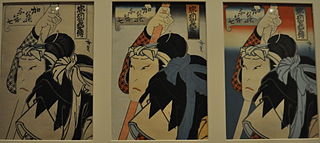
Actor Ichikawa Shikō as Katō Yomoshichi from the series Tales of Retainers of Unswerving Loyalty is an ukiyo-e woodblock print by Osaka-based late Edo period print designer Gosōtei Hirosada (五粽亭廣貞). Each of the three sheets contains a different version of the same image, reflecting progressive stages in the woodblock printing process. The print is a portrait of a contemporary kabuki actor in the role of a samurai, and belongs to a series of images of heroes. The print belongs to the permanent collection of the Prince Takamado Gallery of Japanese Art in the Royal Ontario Museum, Canada.

Actor Ichikawa Ebijūrō as Samurai is an ukiyo-e Japanese woodblock print by Osaka-based late Edo period print designer Shunshosai Hokuchō. The print depicts a scene from a kabuki play featuring Osaka actor Ichikawa Ebijūrō (市川蝦十郎) in the role of a samurai. One impression of the print belongs to the permanent collection of the Prince Takamado Gallery of Japanese Art in the Royal Ontario Museum, Canada.


